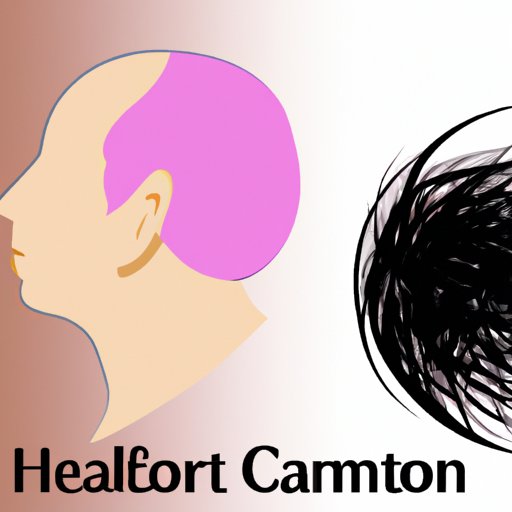Introduction
When someone is diagnosed with cancer, one of the first and most difficult things to process is the potential side effects of treatment. One of the most visible and emotionally challenging side effects is hair loss. Chemotherapy is a particularly aggressive type of cancer treatment, and it can cause severe and permanent hair loss. But does hair grow back after chemo?
This article will explore the reality of hair growth after chemo, as well as provide practical tips for maintaining your hair during and after treatment. We’ll also look at the different types of hair loss associated with chemo and the various treatments available for regrowth.

A Personal Story of Hair Loss and Reggrowth After Chemotherapy
When I was diagnosed with Hodgkin’s lymphoma in my early twenties, I was terrified of the prospect of losing my hair. Even though I knew it was a common side effect of chemotherapy, I still wasn’t prepared for the emotional impact of seeing my hair fall out in clumps.
But the experience wasn’t all bad. In some ways, it was a liberating experience—it helped me to let go of my insecurities about my appearance and instead focus on what was really important: my health. It also taught me that my beauty was so much more than my hair. And, surprisingly enough, it gave me a newfound appreciation for my body’s ability to heal itself. After months of treatment, my hair eventually began to grow back, and it was a beautiful reminder of how far I had come.
Experts Weigh In: What’s the Reality of Hair Growth After Chemo?
Now that we’ve heard a personal story of hair loss and regrowth after chemo, let’s take a look at what experts have to say about the reality of hair growth after treatment. There are several misconceptions about hair regrowth after chemo, so it’s important to get the facts straight.
Common Misconceptions
One of the most common misconceptions about hair regrowth after chemo is that it’s a quick process. While it’s true that hair can start to grow back within a few weeks of finishing treatment, it can take up to six months or longer for hair to fully regrow. Additionally, some people may never regain the same amount or texture of hair that they had before treatment.
Another misconception is that baldness after chemo is permanent. While it’s true that some people may experience permanent baldness, this is usually only the case in extreme cases. For the majority of people, hair regrowth is possible.
The Science Behind Hair Regrowth
So, why does hair grow back after chemo? The answer lies in the science behind hair growth. Hair follicles are made up of cells that divide rapidly, which makes them particularly vulnerable to the effects of chemotherapy. When these cells are damaged by chemo drugs, it can cause temporary or permanent hair loss. However, the healthy follicles that remain are able to regenerate, allowing new hair to grow in its place.

How to Care for Your Hair During and After Chemo
Maintaining the health of your hair during and after chemo is an important part of the regrowth process. Here are some tips for keeping your hair healthy:
Tips for Maintaining Moisture
During treatment, it’s important to keep your scalp and hair moisturized. Use a gentle shampoo and conditioner and avoid harsh chemicals, such as dyes and styling products. You can also use natural oils to help keep your scalp and hair hydrated.
Recommended Products
It’s also a good idea to invest in protective styling products, such as hats, scarves, and wraps. These can help protect your scalp from the sun and wind, as well as reduce friction between your hair and clothing. Additionally, there are a number of specialized products designed to help with hair regrowth, such as shampoos, conditioners, and serums.
A Guide to Hair Regrowth After Chemotherapy
Once you’ve finished treatment and your hair begins to grow back, it’s important to be patient. Hair regrowth usually occurs gradually, and it can take several months for hair to reach its full length. Additionally, it’s important to be aware of the different types of hair loss associated with chemo, as this can affect how quickly your hair grows back.
Different Types of Hair Loss
The two most common types of hair loss associated with chemo are alopecia areata and telogen effluvium. Alopecia areata is an autoimmune disorder that causes patchy hair loss. Telogen effluvium is a condition in which hair follicles enter a resting phase and stop producing new hairs. Both conditions can cause temporary or permanent hair loss.
Treatment Options
If you’re experiencing hair loss after chemo, there are several treatment options available. These include medications, such as minoxidil and finasteride, as well as laser therapy and hair transplants. It’s important to speak to your doctor about the best option for you.
Conclusion
Hair loss is a common side effect of chemotherapy. But does hair grow back after chemo? The answer is yes—for most people, hair regrowth is possible after treatment. It’s important to be patient and follow a healthy hair care routine to promote regrowth. Additionally, there are a variety of treatment options available for those experiencing hair loss.
Losing your hair can be a difficult experience, but it doesn’t have to be. With the right care and support, you can successfully manage your hair loss and regrowth after chemo. Remember, your beauty is so much more than your hair.
Resources for Further Information
American Cancer Society: Hair Loss and Cancer Treatment
Mayo Clinic: Chemotherapy and Hair Loss
National Cancer Institute:


